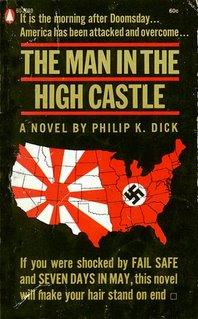Book Review: "The Man In The High Castle” by Philip K. Dick
 It's America in 1962. Slavery is legal once again. The few Jews who still survive hide under assumed names. In San Francisco, the I Ching is as common as the Yellow Pages. All because some 20 years earlier the United States lost a war--and is now occupied jointly by Nazi Germany and Japan.
It's America in 1962. Slavery is legal once again. The few Jews who still survive hide under assumed names. In San Francisco, the I Ching is as common as the Yellow Pages. All because some 20 years earlier the United States lost a war--and is now occupied jointly by Nazi Germany and Japan. In this psychological and societal study, PKD helped to define the alternative history fiction type of story as a serious literary genre. It won the prestigious Hugo Award and helped make Dick well-known in science fiction circles.
The Man in the High Castle's point of divergence from our own world occurred when President Franklin D. Roosevelt was assassinated in 1933. Unable to recover from economic hardship of the ‘30s the U.S. lost World War II. The Eastern Seaboard was placed under German control while California and other western states ceded to Japanese rule. The Southern United States was revived as a quasi-independent state (as a Nazi puppet state like Vichy France). The Rocky Mountain States and much of the Midwest remained autonomous with Nevada becoming the US capital, being considered unimportant by either of the victors, as well as a useful buffer. At the end of the war, the Allied leaders and generals were tried for war crimes (e.g. the carpet bombing of German cities) in a parallel of the Nuremberg Trials.
After Adolf Hitler was incapacitated by syphilis, the head of the Nazi Party Chancellery, Martin Bormann, assumed the leadership of Germany. The Nazis created a colonial empire and continued their mass murder of races they considered inferior, murdering Jews in the puppet United States and other areas they controlled and mounting massive genocide in Africa. However, unlike the Nazis, the Japanese had no policy of cleansing the occupied areas of "unwanted" races. Various factions of the Nazi party are described as either seeking war with Japan or being more interested in colonizing the solar system.
So there lies the basic of what the book consists of, story wise. But deep underneath there is a story of hope. The title of the book comes from a reference to an author in the book, Hawthorne Abendsen who has written a book called “The Grasshopper Lies Heavy.” In this book within a book, Abendsen writes a novel based on the premise that the U.S. won the war and the world is a free place. The Book is banned by the Nazi party and tolerated by the Japanese. In fact many of the Japanese characters in this book have read or have in their possession the book.
The author, Abendsen, lives in a High Castle to prevent attack from the Germans. The book has provided hope for the Americans and Jews to possibly overrun the Nazi rule.
At the same time a couple of machinists working in a factory branch out and start creating jewelry. This causes them to start their own business but when the jewelry some Asian buyers find that the jewelry represents the deep feeling of WU, the Taoist state of emptiness, the creator of the universe.
Therefore one of the many sub-ideas of this is that America is defined by its art and literature and cannot be defeated, as long as there is hope, art and literature.
Once again a classic PKD novel. posted by Gil T. @ 3:10 PM Comments: 0






























